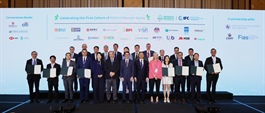New regulations target unlocked consumer credit
New regulations target unlocked consumer credit
Rigid ratios and fixed limits are preventing flexibility by finance companies to adapt to socioeconomic shifts, especially when consumer credit is seen as a key driver for the year-end period.
Last week, the Vietnam Banks Association (VNBA) submitted a document to the State Bank of Vietnam (SBV), addressing difficulties in implementing regulations related to consumer lending.
“The regulation stipulating that the total outstanding consumer loans granted to a single customer by a finance company (FC) must not exceed $4,000 is no longer in line with market realities, reducing the competitiveness of FCs compared to commercial banks,” the VNBA stated in its document. “This forces FCs to focus on designing only small-scale, short-term loan products, thereby limiting their ability to innovate with larger-value or longer-tenor loan packages to meet the market’s diverse needs.”
The VNBA proposed that the SBV consider raising the consumer loan limit to $12,000-16,000. “This would align with thresholds for large-value transactions subject to anti-money laundering reporting, unsecured loans to individuals and households under agricultural credit policies, and small-value credit card lending,” stated the VNBA.
Financial expert Nguyen Tri Hieu recommended that the SBV remove the rigid cap on consumer lending.
“At that point, the SBV could supervise FC operations based on prudential indicators and sound lending criteria, similar to banks. If the consumer loan cap remains too low, it inadvertently creates room for black credit to flourish. Removing the cap would allow FCs more flexibility to meet individual borrowing needs and, in turn, help curb informal lending,” Hieu said.
Regarding proposals to lower the consumer lending ratio from 70 to 50 per cent, Hieu suggested supervision based on prudential ratios such as capital adequacy, liquidity, and non-performing loans.
“The total loan amount granted to individuals should be determined by FCs through their own credit appraisal and based on their equity capital, rather than being subject to an absolute ceiling,” he added. “The SBV could also consider setting a cap whereby consumer lending at FCs does not exceed 5 per cent of equity, to ensure system safety.”
Dr. Nguyen Thi Thu Trang, head of Banking Business at the Faculty of Banking under the Banking Academy of Vietnam, stated that raising the consumer lending limit would create opportunities to expand and accelerate consumer credit growth.
“These proposals could bring significant benefits to both finance companies and consumers, while fostering development of consumer credit. Financial education must also be strengthened to ensure that these changes do not result in negative consequences for the economy and the banking system,” she said.
“Easier access to credit may help consumers meet their financial needs, but could also lead to excessive borrowing beyond repayment capacity, thereby increasing consumer credit risk. Without an effective credit assessment system and sound risk management, debt recovery could become more difficult,” Trang warned.
The first half of the year painted a brighter picture for finance companies, with many reporting strong profit growth, and some even turning losses into gains.
On August 25, Home Credit released its semi-annual financial report. Net profit after tax reached nearly $46.68 million, 2.5 times higher than the same period last year. This figure was only $4.96 million short of its full-year profit in 2024 and already surpassed that of 2023.
In the January-June period, Home Credit successfully issued nine bond tranches worth $144 million. These were all three-no bonds: non-convertible, without warrants, and unsecured, with coupon rates ranging from 6.8 to 7.1 per cent per annum, paid annually.
FE Credit recorded a pre-tax profit of over $10.68 million in the first six months, a remarkable turnaround from a loss of $28.28 million in the same period last year. Q2 also marked the fifth consecutive profitable quarter since Q2 of 2024.
Of particular note was the turnaround of VietCredit in the first half, posting a pre-tax profit of $12.72 million compared to a loss of $7.4 million in the same period of 2024. In Q2 alone, the company generated $9.64 million in pre-tax profit, its highest quarterly earnings ever.
EVN Finance stood out in the group as a special case, with corporate lending accounting for about 95 per cent of its total loan portfolio. The company posted positive results in the first half of the year, with a pre-tax profit of $23.92 million, up nearly 94 per cent compared to the same period in 2024.
Mcredit also delivered notable performance with a pre-tax profit of $2.4 million, exceeding its full-year profit of $2.04 million recorded last year, while HD SAISON reported a six-month pre-tax profit of $28.36 million, representing an 18 per cent increase on-year.
According to experts at MB Securities, the consumer finance sector is expected to gradually recover in the second half of 2025, supported by GDP growth momentum of 8 per cent, improving household incomes, and a more favourable regulatory framework.
“In the medium term, with the International Monetary Fund projecting a compound annual growth rate of 5.5 per cent for per capita GDP in 2025-2030, MB Securities forecasts consumer credit to grow at an average of 20 per cent annually over the next two years, driven by these positive factors,” the experts wrote.
- 09:38 12/09/2025
























